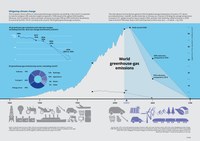
Soil is an important and often neglected element of the climate system. It is the second largest carbon store, or "sink", after the oceans. Restoring key ecosystems on land, and a sustainable use of the land in urban and rural areas, can help us mitigate and adapt to climate change.

The European Union's effort to reduce greenhouse-gas emissions are working. In fact, the EU is expected to meet its unilateral 20 % reduction target (compared to 1990) ahead of the agreed 2020 deadline. Moreover, the EU intends to reduce domestic emissions by at least 40 % by 2030 and further decarbonise its economy by 2050. The EU currently emits around 10 % of global greenhouse-gas emissions.

Climate change is warming the oceans, causing acidification of marine environments, and changing rainfall patterns. This combination of factors often exacerbates of other human pressures on the seas, leading to biodiversity loss in the oceans.

A changing climate will affect almost every aspect of our lives. Increased intensity and frequency of rainfall in many parts of Europe will mean frequent and serious flooding events. Elsewhere in Europe, including in southern Europe, higher temperatures and reduced rainfall will mean that many areas might face droughts.

Agriculture both contributes to climate change and is affected by climate change. The EU needs to reduce its greenhouse-gas emissions from agriculture and adapt its food-production system to cope with climate change. Faced with growing global demand and competition for resources, the EU's food production and consumption need to be seen in a broader context, linking agriculture, energy, and food security.

Climate change is causing a variety of impacts to our health, ecosystems and economy. These impacts are likely to become more serious in the coming decades. If not addressed, these impacts could prove very costly, in terms of ill health, adverse effects on ecosystems, and damaged property and infrastructure.


For reporting on state and trends of biodiversity from an ecosystem perspective, information on the association of species and habitat types to ecosystems is required. The database contains those associations based on butterflies, mammal, reptile and amphibian species listed in European Atlases, all species and habitats considered for reporting under Article 17 of the Habitats Directive and all bird species considered for reporting under Article 12 of the Birds Directive. The species and habitat types are linked to the MAES ecosystems types, which are used under Target 2 of the EU 2020 Biodiversity Strategy. This allocation of species and habitat per ecosystem is done for each of the nine terrestrial biogeographical regions (according to the Habitats Directive) and each marine region (according to the Marine Strategy Framework Directive).





